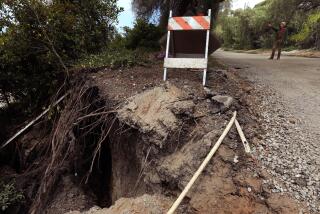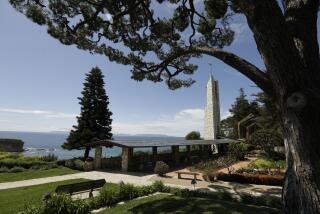Volcanic Bulge Stirs Rumbling Among Oregon Townspeople
- Share via
SISTERS, Ore. — At the Epicure Exchange Internet coffeehouse, it’s hard not to get into a discussion about “The Bulge.”
On computer screens inside, the latest updates on a curious volcanic bulge growing on the flanks of South Sister can be called up in an instant. Through the windows to the west, the dormant volcanic peak dominates the snowcapped skyline of the Cascade Range.
“It’s a big hoopla in town right now. Everybody’s talking about it,” said coffeehouse owner Jeannine Smith, who moved her family to this town of 850 people to be closer to the majestic volcanic peaks that tower above it.
“It doesn’t scare me,” Smith said. But she added: “It is something to be considered.”
About a dozen U.S. Geological Survey scientists are considering it carefully. The current thinking is that an injection of magma is moving under the ground, and a team plans to fly to the Bulge in a helicopter next week to set out instruments to see if it is still growing.
“It is clearly not a crisis we are responding to, as if we were having swarms of shallow earthquakes or anything of that nature,” said USGS geologist Dan Dzurisin. Earthquake swarms can indicate an impending eruption.
Still, the Bulge “is scientifically the most interesting target we have in the Cascades right now,” Dzurisin said.
Ever since Mt. St. Helens erupted on May 18, 1980, the public has been sensitive to any rumblings in the Cascades, a string of volcanoes stretching from British Columbia to Northern California.
Some years after that eruption, people were worrying that Carver Lake, formed by a dam of loose rock pushed up by a glacier on South Sister, might fail and flood the town, recalled the Flyfisher’s Place owner Jeff Perin, standing behind a counter filled with fly-fishing reels.
“People have pretty much forgotten about that,” he said.
When news of the Bulge spread, Nate Turner, who works at the Flyfisher’s Place, got a call from a concerned East Coast pal who has a second home in Sisters.
“I told him I’d throw a sprinkler up on his roof if something was really going down,” Turner said.
Turner recalled when the USGS Cascade Volcano Observatory surveyed South Sister with lasers in 1985 to establish a network of benchmarks to monitor events like the Bulge.
When the volcano was resurveyed in 1986, the Bulge hadn’t shown up. But when new radar satellite imagery was trained on South Sister, USGS geophysicist Chuck Wicks, of Menlo Park, Calif., spotted it.
Wicks was examining images from the European Space Agency’s Interfometric Satellite Aperture Radar, or InSAR, two months ago when the Bulge popped out in a bull’s-eye ring of rainbow colors on his computer screen.
“I think I said, ‘Wow, this is great,’ something like that,” said Wicks, an Oregon native.
Wicks compared digital images of the west side of the volcano taken in 1996 and 2000 and saw a rise of 4 inches spread over a 10-mile-wide circle in the headwaters of Separation Creek.
It is too soon to tell exactly what is going on, but the best guess is that a relatively small amount of magma is moving about 12 miles underneath the surface, said Wicks.
In volcanic terms, small is still pretty big: The magma would probably fill a swimming pool measuring a half mile on each side and 50 feet deep.
Wicks hopes the InSAR satellite, which has already outlasted its design life, will survive long enough to take another image this summer. A replacement isn’t due to be launched until fall.
In the meantime, scientists plan to install a Global Positioning System monitor and a seismometer on the Bulge next week.
The GPS monitor will detect changes in elevation as small as a couple of millimeters. The seismometer will detect any small earthquakes, the most reliable predictor of an eruption, said Dzurisin.
The instruments will be connected to the Internet by radio telemetry, so scientists will be able to read them daily from their offices.
If the Bulge is still growing, the scientists might put more GPS monitors and seismometers in the area, resurvey the 1985 benchmarks and take air samples to check for traces of volcanic gases.
“I suspect these kinds of ground swellings probably go on in the Cascades and at other volcanoes, and most of them--maybe even the vast majority--don’t lead to eruptions,” Dzurisin said. “If we had not had the radar technology, we might never have noticed. This is what volcanoes do.”
InSAR has detected lots of bulges on volcanoes in the Aleutian Islands in Alaska, and none has led to an eruption, said Dzurisin.
That would be fine with Jim Wills, who has a view of South Sister over his shoulder when he sets out tubs of strawberries and blackberries at Richard’s Produce stand.
“I remember Mt. St. Helens,” he said. “I don’t want to see that around here.”
More to Read
Sign up for Essential California
The most important California stories and recommendations in your inbox every morning.
You may occasionally receive promotional content from the Los Angeles Times.













